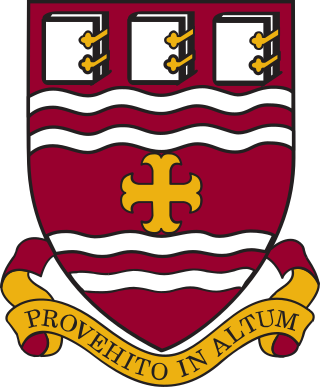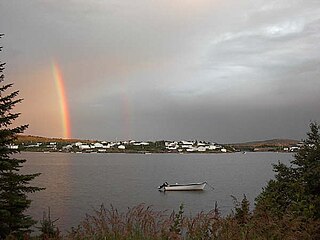Related Research Articles

Memorial University, or MUN, is a public research university in the province of Newfoundland and Labrador, based in St. John's, with satellite campuses in Corner Brook, Happy Valley-Goose Bay, Saint Pierre, and Harlow, England. Memorial University offers certificate, diploma, undergraduate, graduate, and post-graduate programs, as well as online courses and degrees.
Clarenville is a town on the east coast of Newfoundland in the province of Newfoundland and Labrador, Canada. Clarenville was incorporated in 1951. It is located in the Shoal Harbour valley, fronting an arm of the Atlantic Ocean called Random Sound.

Sir Wilfred Thomason Grenfell was a British medical missionary to Newfoundland, who wrote books on his work and other topics.

St. Anthony is a town on the northern reaches of the Great Northern Peninsula of the Canadian province of Newfoundland and Labrador. St. Anthony serves as a main service centre for northern Newfoundland and southern Labrador. St. Anthony had a population of 2,180 in 2021, compared with 2,258 in 2016, 2,418 in 2011, 2,476 in 2006 and 2,730 in 2001.

Hebron was a Moravian mission and the northernmost settlement in Labrador. The traditional Nunatsiavummiutitut name for the area means "the Great Bay". Founded in 1831, the mission disbanded in 1959. The Inuk Abraham Ulrikab and his family, exhibited in human zoos in Europe in 1880, were from Hebron.

Colonel Cluny Macpherson was a physician and the inventor of an early gas mask. After World War I he served as the president of the St. John's Clinical Society and the Newfoundland Medical Association.

Battle Harbour is a summer fishing station, formerly a permanent settlement, located on the Labrador coast in the province of Newfoundland and Labrador, Canada. Battle Harbour was for two centuries the economic and social centre of the southeastern Labrador coast. Mercantile saltfish premises first established there in the 1770s developed into a thriving community that was known as the Capital of Labrador. It fell into decline following reductions in the cod fishery and a major fire in 1930, and was abandoned as a permanent settlement following government resettlement activity in the 1960s.
The Grenfell Mission was a philanthropic organization that provided medical and social services to people in rural communities of northern Newfoundland and Labrador. It was founded by Sir Wilfred Grenfell in 1892 as a branch of The Royal National Mission to Deep Sea Fishermen based in Britain.

CCGS Sir Wilfred Grenfell is a Canadian Coast Guard vessel based in Victoria, British Columbia. Designated an "Offshore Ice Strengthened Multi Patrol Vessel", the former offshore supply vessel is named after the medical missionary in Labrador, Sir Wilfred Grenfell. Constructed in 1984–1985, Sir Wilfred Grenfell was purchased by the Canadian Government and converted for Coast Guard service. In 1994, she played an important role in the fishing conflict known as the Turbot War in the Atlantic Ocean.
William Anthony Paddon, was a Canadian surgeon and the seventh lieutenant governor of Newfoundland from 1981 to 1986.

Lewis Varick Frissell was an American documentary filmmaker. His last film, The Viking, set in Newfoundland, involved the largest loss of life of a film production crew in history. This film was also "the first film to record sound and dialogue on location".

Harbour Breton is a small fishing community on the Connaigre Peninsula in Fortune Bay, on the south coast of the island of Newfoundland in Canada. It is the largest center on the Connaigre Peninsula and was long considered the unofficial capital of Fortune Bay. During the 1960s many communities were resettled into Harbour Breton. Harbour Breton is the only administrative centre in Fortune Bay and is located approximately 220 kilometres (140 mi) south of Grand Falls-Windsor.

Fishermen's Mission, officially The Royal National Mission to Deep Sea Fishermen (RNMDSF), is a British charitable organisation founded in 1881 to help those working in the UK's fishing industry. The charity, which is run on Christian principles, supports and welcomes persons of all faiths and none. It was founded at the end of the 19th century (1881) to provide assistance and support to the impoverished fishing communities around the coasts of Britain.

North West River is a small town located in central Labrador. Established in 1743 as a trading post by French Fur Trader Louis Fornel, the community later went on to become a hub for the Hudson's Bay Company and home to a hospital and school serving the needs of coastal Labrador. North West River is the oldest modern settlement in Labrador.

Mary's Harbour is a town in the Canadian province of Newfoundland and Labrador. The town had a population of 312 in the Canada 2021 Census, down from 341 in the Canada 2016 Census. It is serviced by Mary's Harbour Airport.

Brig Bay is a local service district and designated place in the Canadian province of Newfoundland and Labrador. It was first mapped by Captain James Cook in September 1764. The name "Brig" was adopted by the French who occupied the bay prior to English occupation. It provided a safe and well-sheltered harbour.
Grenfell Campus, formerly Sir Wilfred Grenfell College, is a campus of the Memorial University of Newfoundland (MUN). It is located in the city of Corner Brook, Newfoundland and Labrador, Canada. The campus has approximately 1,300 students enrolled in degree programs for the arts, education, fine arts, science, resource management and nursing. Many students from around the province also attend the school for the first- and second-year course offerings before transferring to Memorial University's larger campus in St. John's.
Kirkina Mucko also known as Elizabeth Mukko, (1890-1970) was a Canadian Inuit nurse and midwife. Having lost her legs as a child, and possibly her parents, she was raised in a series of mission homes, hospitals and boarding schools. Returning from abroad around 1908, she worked at the Grenfell Mission in Labrador. After losing family members in the 1918 flu pandemic, Mucko trained as a nurse and midwife, providing services for her community until her later years. A women's shelter in Rigolet has been named in her honor.
A public apology is a component of reparation as stipulated in the United Nations Office of the United Nations High Commissioner for Human Rights resolution proclaiming the Basic Principles and Guidelines on the Right to a Remedy and Reparation for Victims of Gross Violations of International Human Rights Law and Serious Violations of International Humanitarian Law. It is also defined as a restorative process intended to heal and to generate forgiveness on the part of the offended party, for the improper behavior or action of the offender. The process consists in three components: acknowledgment of wrongdoing, admission of responsibility and the action of the wrongdoer to compensate damages produced.
Henry Locke Paddon was a British doctor and medical missionary in Canada.
References
- ↑ Coombs-Thorne, Heidi (2017). "Grenfell Mission Heroines". Canada's History. 97 (4): 28–33. ISSN 1920-9894.
- ↑ "'We cannot forget the history': Justin Trudeau apologizes to N.L. residential school survivors". CBC News. Retrieved 2017-11-25.
- ↑ Austen, Ian. "Trudeau Apologizes for Abuse and 'Profound Cultural Loss' at Indigenous Schools". The New York Times. Retrieved 2021-08-01.